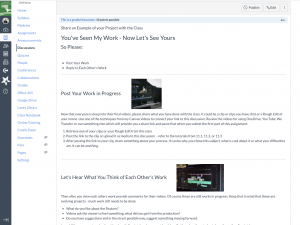By Steve Shlisky
SF Chapter President / Media Communications Chair Laney College
The COVID-19 pandemic slowly eclipsed the spring term for college students in our Chapter colleges – a fade through black at the exact halfway point in the semester. On March 12th, Oakland’s Laney College department chairs met with the Vice President of Instruction. He explained that the college would shut down for 3 weeks to prepare for remote instruction. This was voluntary for those classes which could be taken to an online format. With Alameda County’s shelter-in-place order four days later all classes would be ordered off campus. And, fading up, we headed into April and then into May online. Summer classes in June and July will also re-rack and teach remotely.
By mid-March, my Beginning Video Production students would have started to film their major projects. By April they would be editing. Each student wrote their own narrative or documentary, many featured locations off campus into the Oakland community. By April, these productions folded due to a violation of the Shelter-in-Place (SIP) order and congregating crowds rules. Even one and two person crews were saddled with Social Distancing observations.
The Career and Technical Education (CTE) teachers’ knee jerk aversion to Distance Education (DE) instruction is understandable. Teaching a hands-on curriculum hands-off seems counter intuitive. Professors asserted that students would not get the quality instruction which would immediately be valuable to further a professional or academic setting. Many CTE courses like Carpentry, Welding, Culinary Arts and Media Creation rely on sophisticated professional tools not available to SIP students. Media creation classes provide students with professional grade cameras, microphones, lights and editing equipment for immersive study and to develop skill sets.
Chapter Governor and Laney College photography instructor Mike Moya adapted his photography classroom into a remote online course: “I had some major obstacles. Condensing a 5-hour classroom lecture and lab into a suitable online format was to be expected. The transition for my students to acclimate to an online format was far more overwhelming.” Moya saw two thirds of his students walk away from a class they were halfway through:
“Our photography program is recognized by students as being one to the leading institutions for vocational training necessary in the work force. This is only possible because of our technical facilities, adjunct instructors, and technical equipment available for this training.”
The online learning environment is primarily asynchronous. Students may meet together for an hour on a Zoom conference but the rest of the time they set their own hours and learn on their own. Many professors or adjuncts who teach media courses are working industry professionals who teach only a class or two at a local college. As CTE professors like Moya try to replicate the connected interaction of face-to-face classes online, the struggle is acute: “I have students who have dropped my classes because they feel they will not get the instruction needed from an online course.”
Laney College student Shirin Bina says she hates online courses: “I can’t stand the conversation that technology should, or can, be used as a replacement to the in-person experience. Even if we get to a world where we achieve a perfectly seamless virtual classroom environment, it still is nowhere on par with the in-person environment.”
Leslie Santibañez feels she is not getting the training she needs. A senior at San Francisco State’s Broadcast and Electronic Communication Arts (BECA) Department, Santibañez recently lost her retail job due to the pandemic: “It’s a bit scary. My biggest fear was graduating into a recession/depression, and now that has become a reality. My graduation has been cancelled and It is a bit terrifying. I still have to pay rent for my apartment in SF, and I am trying to figure out when I will go back up to pick up my belongings because I know I sadly won’t be coming back to SF.”
Laney College already had two viable tools for online instruction: Zoom for teleconferencing, and Canvas, a digital learning environment adopted by some schools for creating online lessons. Zoom is relatively easy to master, once you set a meeting time, a link is sent to students. The learning curve for Canvas is steeper. The District has provided limited paid training and extensive “how-to’s” for self learning. There is no requirement to use these specific online tools. It is up to each individual professor to continue the semester as best they can. Students could drop classes with little penalty, with no harm to their Grade Point Average (GPA), and can retake these classes again in the future.
Canvas attempts to recreate the classroom experience through Distance Education (DE). I use one ninety-minute Zoom Conference each week for lectures, and use Canvas to round out the lab portion. Students work on these labs at their own pace and can schedule short one-on-one Zoom meetings with me. Lessons can be organized in many different ways and there are many tools available for teachers to mold into the needed curriculum. Canvas does not recreate the tactile environment I am used to with my students but it does provide a structure for assignments, discussions, and tests, all of which can be graded or non-graded. Canvas allows professors to initiate discussions as an activity to engage more student participation. Teachers look for ways to enhance student ownership of the discourse by allowing them to choose topics, create space for exploratory discussion, and to limit the professor’s presence.
- San Jose Stare University (SJSU) Engineering Faculty member Ahmed Banafa has 16 years of online teaching experience: “Online classes come with many components – discussions, assignments, online tests. It’s not easy to make the switch if you never taught online. First week when we decided to switch, I created a video telling the students what we will do and posted it on Canvas, posted the link to Zoom, and emailed it before every class. The most important element in teaching online is communications both ways – students and instructor. Switching to virtual teaching was like crisis management practice: keep them informed, stay visible and deliver all the news at once and keep them updated.” DE enables experts from all over the world to add to the curriculum. SJSU Engineering
Professor Barbara Murphy-Wesley, who teaches in SJSU’s Environmental Writing Program, exploits the digital world-wide reach: “Because our TV production team has helped us with everything from televising a Zoom broadcast live from Australia, to televising local speakers, we were able to easily adapt when we had to meet the challenges brought about when the campus was shut down.”
Chair of the Communication Studies Department at Sacramento State University Gerri Smith, PhD says her school’s administration works diligently to help smooth out technology intense disciplines: “For those students without the necessary technological support, the university employed a laptop checkout program and offered specified university spaces with access to WiFi, of course with appropriate social distancing practiced.”
- Students worried about dealing with DE and keeping up with the rigors of the curriculum have new alternatives: “For most courses students will be able to opt for a Credit/No Credit option, which will not impact their GPAs. We are doing everything we can to ensure student success this semester for all, despite the remote learning environment and the additional challenges our students are facing.” Smith adds: “I am very proud of the faculty, who made the required instructional pivot. With very little time for preparation and implementation. Many are employing highly innovative strategies for student engagement despite not being in a traditional classroom. Indeed, we are all experiencing an intense ‘Zoom Boom’ where many classes and meetings occur using the Zoom platform.”
- Chapter Governor and Adjunct Professor Kim Stephens says: “I’m as hands-on as is possible while on Zoom, teaching students how to produce a newscast or write a story, but I know my students would be asking me more questions if we were in the classroom together.” Stephens teaches an Intermediate Broadcast and Online Newswriting and TV/Multimedia News Reporting and Production classes at Fresno State University. Many of her students are doing well, but some are having a difficult, emotional time balancing home and school life.
“My newscast class is still putting together its 30-minute newscast each week but now they’re interviewing people virtually. I’m exceptionally impressed with those students. This is their capstone class – the one that helps them put together their reporter reel. Well, those reels will look different, but they are getting creative. This is forcing them to think differently in getting stories and setting up interviews which I think will only help them in the long run.”
“Quarantine news teaching has been quite the trip”, says San Francisco State University’s Dina Ibrahim Ph.D. “We initially pivoted our weekly live newscast straight to the web & social posts, then after spring break we did two post-produced shows from home.” Ibrahim a BECA professor will try out going live from 10 locations for their last two newscasts of the semester on May 5th & 12th. Both Tuesday dates will be at noon on their YouTube Channel.
Ibrahim is looking to get something deeper than what Zoom Conferencing offers. She’s been researching live options: like “Wirecast,” a live Streaming App by Telestream; and TVU Producer, a cloud based TV Production program.
- “At the heart of the BECA program is embracing failure and unchartered production territory, learning from it, and most of all be entertained as we learn. We’ll keep iterating until we get it right. My reporter students are doing an absolutely incredible job from home with no resources, and are eager to prove themselves to potential employers with rock star sizzle reels. The producers are excited to learn new software that will showcase their innovation and creativity under pressure. I have no doubt that recruiters will appreciate their grace and resilience.”
Ibrahim’s student Madison Macay now in her third year in BECA says: “Nothing will ever replace hearing the ten second countdown before going live for my school’s weekly newscast, “State of Events.” However, moving our pitch meetings and holding our interviews on Zoom, has opened my eyes to how truly eclectic the definition of journalism can be.”
What was a slow dissolve to online education has become a hard-cut triggered by Covid-19. Embracing new technology paradigms usually comes by evolution. Now after a few month’s in the DE world, some professors fear we will not go back to a 100% face-to-face classroom again. Laney College’s Moya is concerned that his students will sacrifice an education for convenience: “Yes the internet is bombarded with tutorial based knowledge and I myself have had to design video tutorials for my typical classroom instruction but at what cost. Students understand the difference between computer based content and the personal classroom experience. Despite the hours of research and professional development, I have a new appreciation for the relationships we develop and the success of our students that only the classroom is capable of offering.”
Media students caught in this academic stay-at-home net extract the good within the difficult.
For Laney’s Beginning Video Production student Bina: her goal was connecting with other media minded people: “Technology helps garner those connections, no question (but) there is no substitute to being in a room together with your teacher and peers, and everyone is present together. Or breaking off in groups to create a project together.”
BECA student Santibañez has evolved her expectations: “In a way working remotely has pushed me to find new creative ways to display and interview subjects, such as working on graphics. Most of the interviews are done remotely now, so I have been brushing up on my After Effects skills. I think if the quarantine hadn’t been implemented, I wouldn’t have pushed myself to learn this as much as I am now. This is useful because my dream job I hope to have one day is working for Vox producing their videos or editing them.”





















